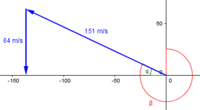amathproblemthatneedsolve
Junior Member
- Joined
- May 12, 2019
- Messages
- 189
A plane flys due east at a constant airspeed of 151ms^-1. The wind blows at a constant speed of 64ms^-1 from the north. Calculate the resultant speed and the direction of the aircraft.
So I was thinking. V^2=151^2+64^2 . V=164km h^-1
Tan θ= 64/151 θ=23degrees The air speed is 164km in the direction 23degrees south-east.
let's say the aircraft came somewhere from California and went to Kansas. On the return journey, the pilot wants to fly directly back from Kansas to California . The air speed of the plane is 151ms^-1 and the wind still blows at a constant speed of 64ms^-1 from the north.
In what direction must the plane head to reach California?
So I believe the pilot has to fly at an angle of 23degrees N of W to correct for the wind
What will be the resultant speed? Would this just be the same?
So I was thinking. V^2=151^2+64^2 . V=164km h^-1
Tan θ= 64/151 θ=23degrees The air speed is 164km in the direction 23degrees south-east.
let's say the aircraft came somewhere from California and went to Kansas. On the return journey, the pilot wants to fly directly back from Kansas to California . The air speed of the plane is 151ms^-1 and the wind still blows at a constant speed of 64ms^-1 from the north.
In what direction must the plane head to reach California?
So I believe the pilot has to fly at an angle of 23degrees N of W to correct for the wind
What will be the resultant speed? Would this just be the same?
Last edited:

